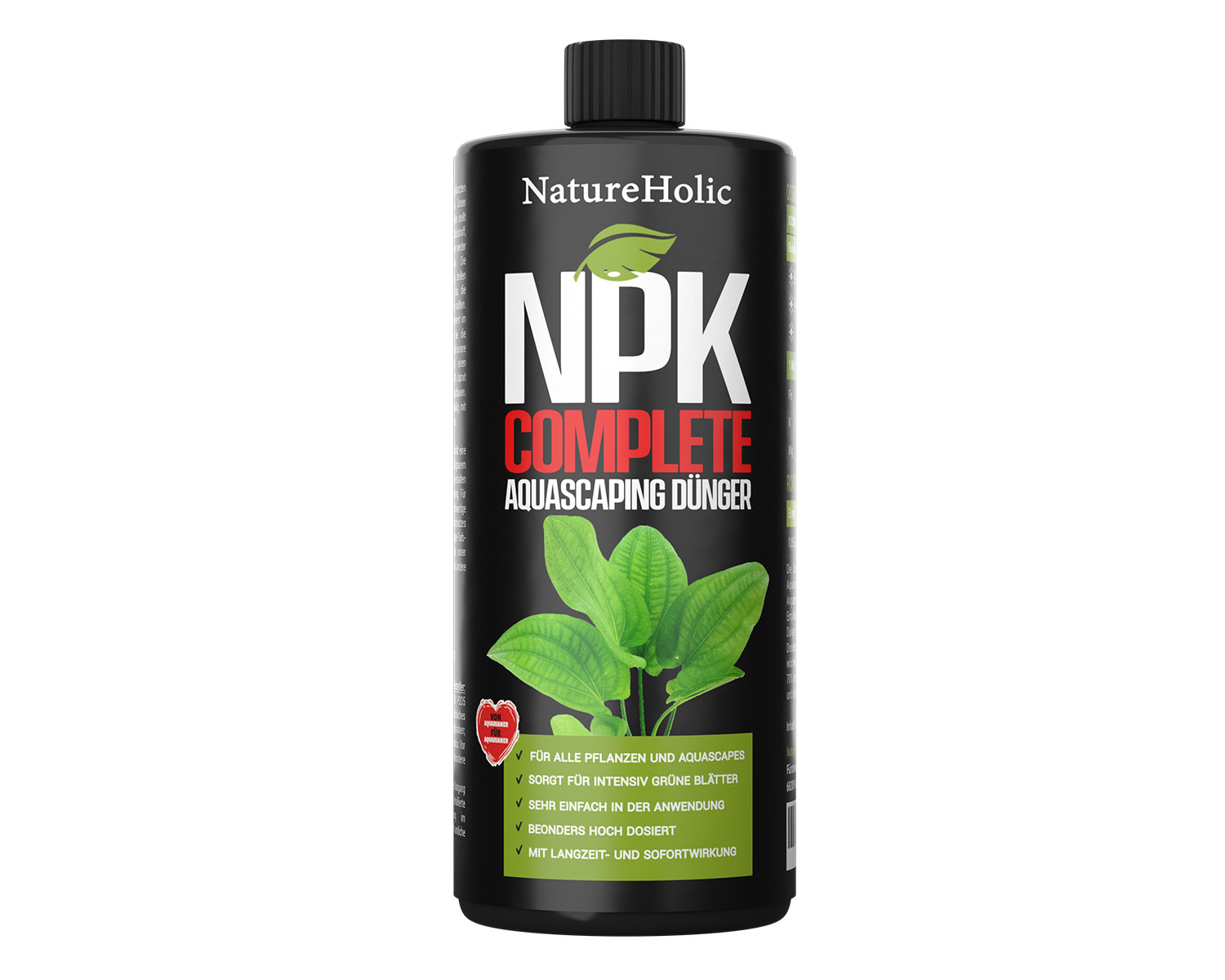The correct plant fertilization in the aquarium
How to fertilize aquarium plants properly?
Only the hardiest aquarium plants can manage so completely without an additional supply of nutrients, and even they can only grow if they receive at least a minimum of the building materials from which they can build their tissue. In aquariums with tap water, only the particularly hard and slow-growing aquarium plants, such as Anubias or Bucephalandra, receive sufficient nutrients. The same applies to salted osmosis water, which is brought to an appropriate water hardness with mineral salt. In some cases you can also add nutrients with fish food or shrimp food, but in a well planted aquarium or aquascape, where only a few aquatic animals are paddling, even this will not be enough. For this reason, aquarium plants in such a setup must be "fed" nutrients just as much as the animals in the tank. Again, a balanced "diet" is essential for the health of the organisms! In this context, nutrient supply plays an important role in the growth and development of aquarium plants, in addition to a good supply of carbon in the form ofCO2 and a good supply of light.
Differentiation between micronutrients and macronutrients
There are substances of which aquarium plants need a larger portion - the so-called macronutrients or macros. These include nitrogen (N, often in the form of nitrate or NO3, which is readily available to plants), phosphorus (P, usually in the form of phosphate or PO4), potassium (K) and magnesium. Substances of which plants need only small amounts are defined in plant aquaristics as micronutrients or micros. However, these trace elements should not be underestimated - even if plants do not need huge amounts of them, they cannot grow without iron, copper, molybdenum, boron and others.
Micronutrients are usually given in combination, because it would hardly be worthwhile to produce a separate fertilizer for each of the tiny amounts. These fertilizers are often called iron fertilizers or trace element fertilizers. Macronutrients can be added to the aquarium either in combination as so-called NPK fertilizers or (if, for example, you work with tap water in the aquarium, which already has a high nitrate value by nature) as individual components. This type of fertilization requires, of course, that the value of the individual substances in the aquarium water is known, which you can achieve by using an appropriate water test, which you can of course also buy here in the store. In addition to a wide range of liquid fertilizers, NatureHolic also offers our Super Red fertilizer tablets especially for the root eaters among the aquarium plants.

The new fertilizer line from NatureHolic
With our new high-yield aquascaping fertilizers, we offer you a high-quality and affordable way to supply your aquascape and planted aquarium with nutrients from the microelement and macroelement range. In the following we present our fertilizers in detail and explain what they can do and what you need them for. Our fertilizers have both a long-term effect and an immediate effect - so your plants will benefit directly from the addition of the valuable plant nutrients to the aquarium.
We have made sure that the fertilizers for aquascaping are composed in such a way that they can also be used without hesitation in aquariums with invertebrates - provided, of course, that you follow our dosage instructions. You can also combine the fertilizers in any way you like without any harmful consequences for your aquarium inhabitants.
Please note: All dosage recommendations are only guidelines - we do not know the conditions in your planted aquarium. Please observe your aquarium well and adjust the values upwards or downwards according to the individual needs of your aquarium plants. You should monitor the respective value with an aquaristic water test. If one or more of the parameters increase too much, reduce the amount of fertilizer accordingly.
Basically we recommend a weekly partial water change of approx. 25-70%. This will remove excess nutrients and prevent nutrient peaks from forming in the aquarium water, which in turn would only benefit the algae.
Protecting the environment and the issue of sustainability are extremely important to us at NatureHolic, and we also consistently focus on omitting superfluous things like fragrances and dyes from our aquarium fertilizers. Our NatureHolic aquascaping fertilizers are high-yielding and highly compatible. They come in containers of 250 ml, 500 ml, 2000 ml or 5000 ml.

NatureHolic Nitrate Booster
With the phosphate-free NatureHolic Nitrate Booster you supply the important macronutrient nitrogen (the N in NO3, the chemical formula of nitrate), which your aquarium plants need to grow well and healthy. In addition, the nitrate fertilizer from NatureHolic also brings a small amount of the important plant nutrients potassium and magnesium.
Nitrogen deficiency in the aquarium leads to the fact that the plants grow puny and slow and form only small leaves. In extreme cases, they even stop growing completely. This is the hour of the green algae: You can often recognize a nitrogen deficiency by the mass appearance of filamentous algae and/or green furry algae. Green algae coatings on the aquarium glass are also often caused by a nitrogen deficiency and the associated poor plant growth in the aquarium.
If the nitrogen deficiency is corrected, the plants grow better again and regain their vital appearance. Often this is enough for the algae in the aquarium to disappear.
The target value for nitrate in a planted aquarium is 10-20 mg/l. In a well planted aquascape, fertilized withCO2 and illuminated with strong light, dose 2 ml of Nitrate Booster per 100 liters per day, without CO2 supply 0.5 ml. Medium-lit planted aquariums with CO2 fertilization receive 1 ml per day, without CO2 supply 0.25 ml is dosed. Aquarium plants in low-light aquariums with CO2 fertilization receive 0.5 ml, without CO2 supply 0.1 ml Nitrate Booster per 100 liters of aquarium water is sufficient. With 1 ml, the following nutrient levels are achieved in 100 liters of aquarium water: 1.06 mg/l nitrate, 0.44 mg/l potassium, 0.03 mg/l magnesium and 0.06 mg/l calcium.
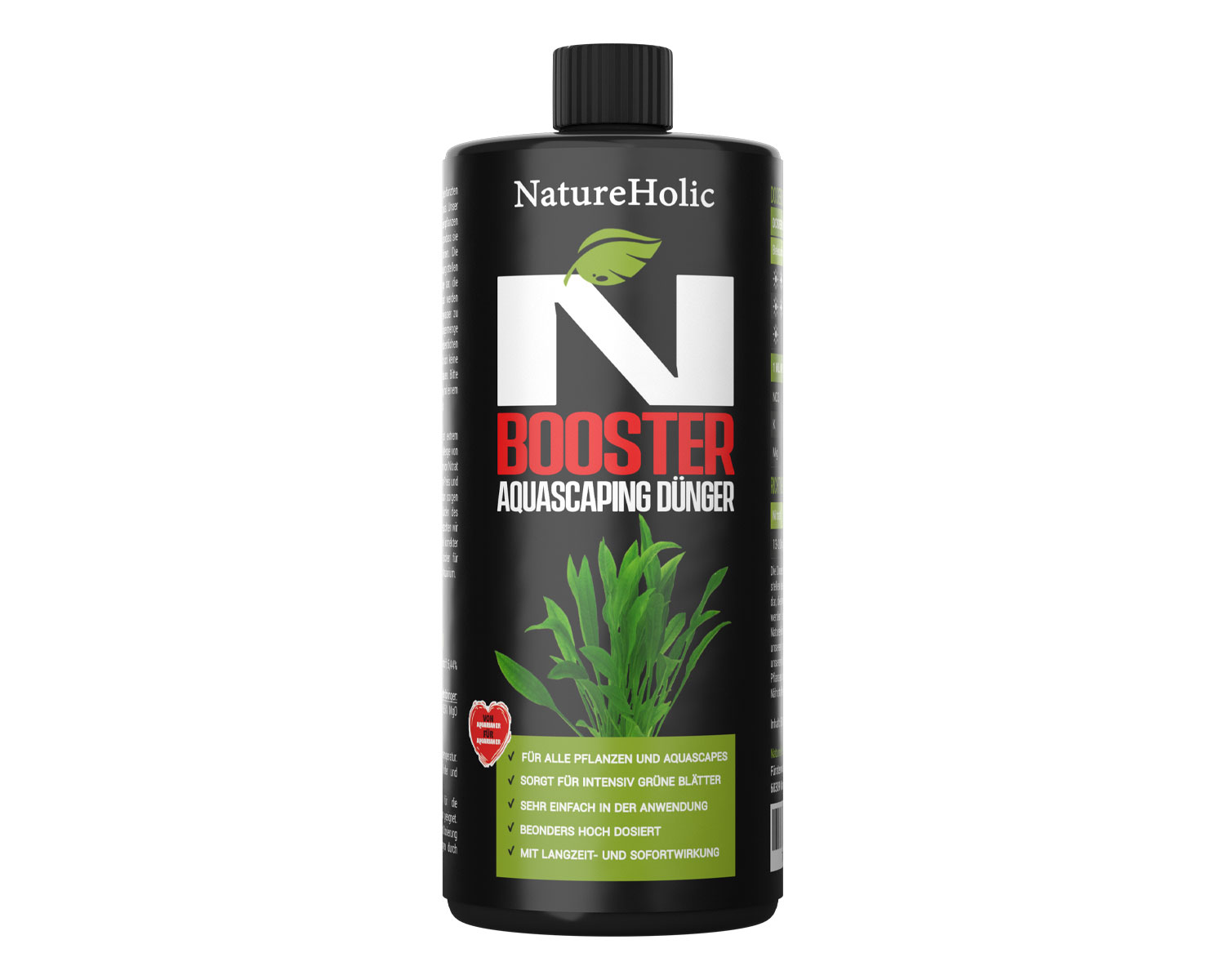
NatureHolic Phosphate Booster
NatureHolic Phosphate Booster brings phosphorus (P) for the plants, which they urgently need for the energy transfer in the organism and for cell respiration. Phosphorus also plays an important role in building cellular material. While excess phosphate (PO4) is said to be responsible for algae infestations, this is predominantly not due to the presence of phosphate, but to the absence of the other nutrients. Algae generally like to take advantage of nutrient peaks or gaps.
A lack of phosphorus is noticeable in the aquarium plants in stunted growth and a darker coloration of the leaf tissue. The dark coloration occurs because although the leaf shrinks with a phosphorus deficiency, the number of chloroplasts does not decrease with the leaf green. Furthermore, in the case of phosphorus deficiency, the plant may drop leaves. Especially the older parts of the plant are affected by this leaf loss.
If, thanks to the NatureHolic Phosphate Booster, sufficient phosphorus is again available for the aquarium plants, the plants can form their leaves again in full size and grow healthy and strong. Then they also represent again a strong competition against annoying algae plagues.
A target value of approx. 0.1-0.4 mg phosphate per liter of aquarium water represents the goal of fertilization. In an aquarium with strong light and with CO2 fertilization, add 2 ml of Phosphate Booster per 100 liters per day; in a strong light setup without CO2 supply, add 0.5 ml. Aquariums with medium strong light with CO2 fertilization are supplied with 1 ml, without CO2 supply with 0.25 ml. In low light aquariums with CO2 fertilization dose 0.5 ml, without CO2 supply 0.1 ml Phosphate Booster per 100 liters of aquarium water. 1 ml NatureHolic Phophate Booster raises the phosphate content in 100 liters of aquarium water by 0.29 mg/l.
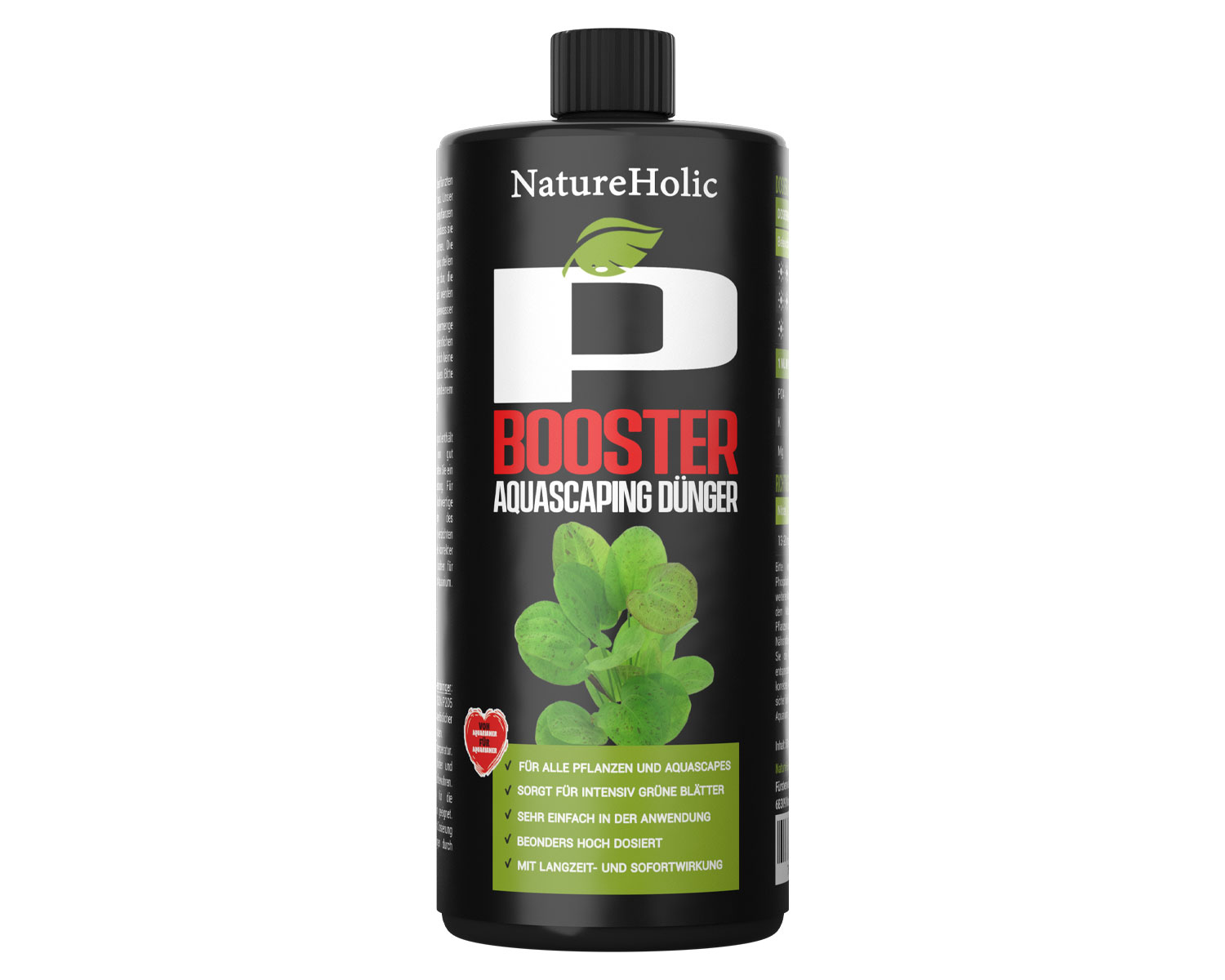
NatureHolic Potassium Booster
The liquid NatureHolic Pot assium Booster provides aquarium plants with vital potassium (K). They need the element for the regulation of their water balance and for the transport of nutrients in the plant tissue and thus ultimately for healthy plant tissue.
A potassium deficiency in aquarium plants manifests itself in necroses: black discolorations of the leaf tissue, which can gradually become holes. In some cases - as in the case of java ferns, for example - entire leaves may first turn yellow and then black as they gradually die and are then shed. A potassium deficiency also manifests itself in slow plant growth and a general lack of vitality.
NatureHolic Potassium Booster brings immediately usable potassium to plants, allowing them to grow back to health so that discoloration no longer occurs in regrowing leaves.
NatureHolic Potassium Booster can be given daily or weekly. The target value for potassium in the aquarium is 10-15 mg/l potassium per liter of aquarium water. In a high light aquarium with CO2 fertilization, add 2 ml of Potassium Booster per 100 liters per day, and in a high light setup without CO2 supply, add 0.5 ml. Aquariums with medium light and CO2 fertilization receive 1 ml, without CO2 supply 0.25 ml. In low light aquariums with a CO2 fertilization, add 0.5 ml, without CO2 supply add 0.1 ml of Potassium Booster per 100 liters of aquarium water. 1 ml NatureHolic Potassium Booster raises the potassium level in 100 liters of aquarium water by 0.29 mg/l.

NatureHolic Magnesium Booster
The element magnesium (Mg), which NatureHolic Magn esium Booster brings, is important for the photosynthesis of plants in the aquarium: the plants need the substance to form chlorophyll. In addition, many metabolic functions in the plant depend on magnesium, and it is an important building block for plant tissue.
A magnesium deficiency in aquarium plants manifests itself similarly to an iron deficiency in yellowish-pale discolorations of the leaf tissue, while the leaf veins remain green - a classic leaf chlorosis. Unlike iron deficiency, magnesium deficiency causes the older leaves of aquatic plants to discolor first.
If you give your aquarium plants with the NatureHolic Magnesium Booster again sufficient magnesium, they form again more chlorophyll, the discolorations disappear and the leaves become again juicy green and look stronger and less flabby.
NatureHolic Magnesium Booster is best given daily. The target level for magnesium in the aquarium is 10 or more mg per liter of aquarium water. In an aquarium with strong light and an additional CO2 fertilization you dose 2 ml Magnesium Booster per 100 liters per day, in a strong light aquarium without CO2 you give 0.5 ml. Aquariums with medium light and a CO2 fertilization system are supplied with 1 ml, those without a CO2 fertilization system with 0.25 ml of fertilizer. In low light aquariums with a CO2 supply add 0.5 ml, without CO2 fertilization add 0.1 ml Magnesium Booster per 100 liters of aquarium water. 1 ml NatureHolic Magnesium Booster raises the magnesium level in 100 liters of aquarium water by 0.12 mg/l.
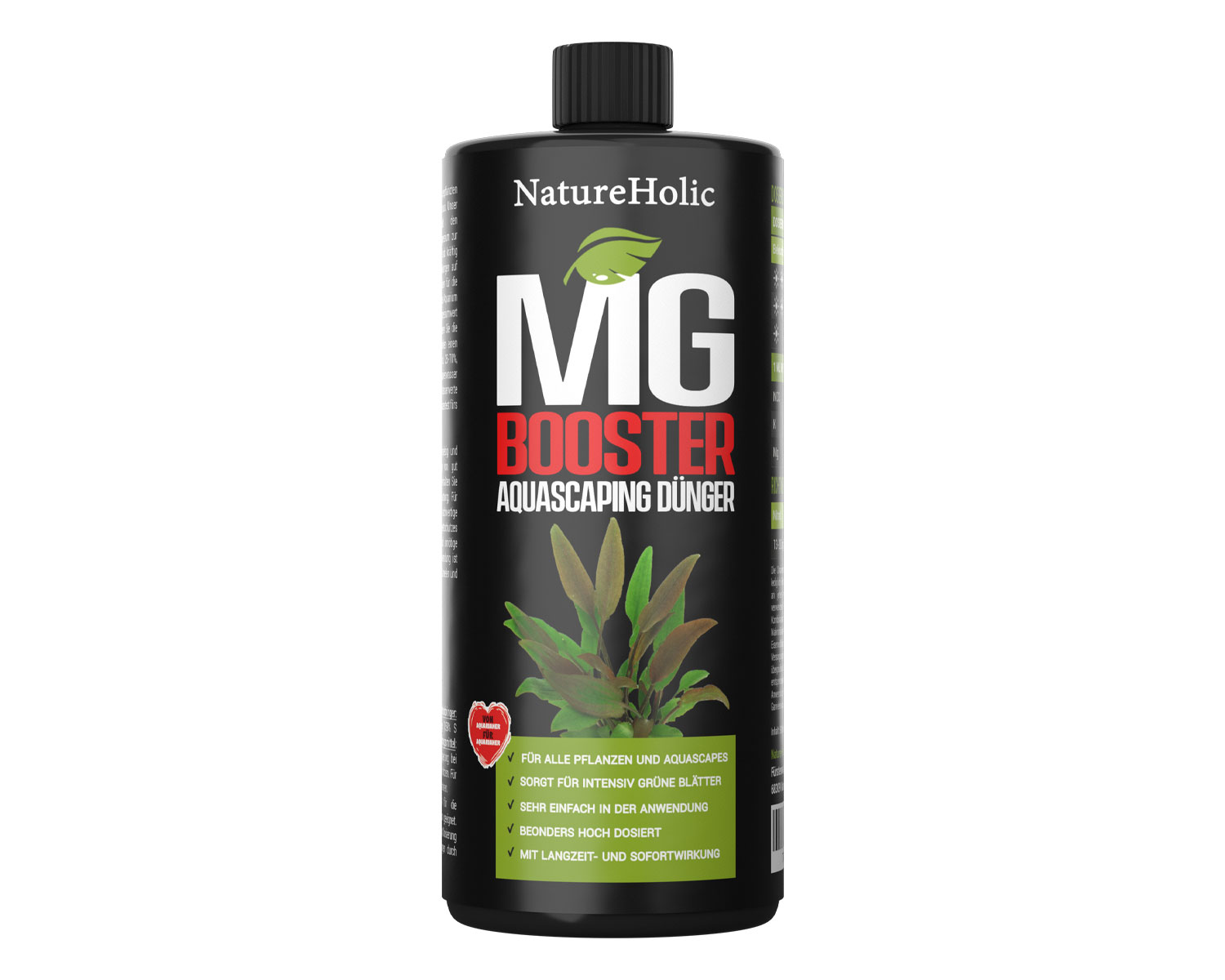
NatureHolic Iron Booster
In addition to iron (Fe), NatureHolic Iron Bo oster liquid fertilizer for aquascaping also brings the macronutrient potassium (K), magnesium (Mg) and many important trace nutrients: Manganese, Zinc, Boron, Molybdenum and a very small amount of copper, which is guaranteed harmless to shrimp. Aquarium plants need iron to produce the green leaf pigment chlorophyll.
An iron deficiency manifests itself in the aquarium in pale leaf colors and dull-looking plant leaves, in bad cases also in chlorosis of the plant leaves. The leaf tissue becomes pale, yellowish to whitish, and only the leaf veins stand out green. The new shoots look puny and are also discolored to whitish, yellowish or a washed-out pink.
For radiant leaf colors of red and green aquarium plants, our liquid trace element fertilizer NatureHolic Iron Booster is indispensable. Discolorations disappear, the leaves grow more vigorously again and the new shoots look vital and strong.
NatureHolic Iron Booster is best given daily, as soon as the light in the aquarium comes on - then the plants can use the nutrients best. The target level for iron in the aquarium is 0.05-0.2 mg/l, for potassium 10-15 mg/l, and magnesium should be above 10 mg/l. In an aquarium with strong light and additional CO2 fertilization, the nutrient requirement is high. Here you dose 2 ml Iron Booster per 100 liters per day, in a strong light aquarium without CO2 you add 1 ml. Aquariums with rather medium light and CO2 fertilization system are "fed" with 1 ml, without CO2 fertilization with 0.6 ml fertilizer. In low light aquariums with a CO2 fertilization system dose 0.6 ml, without CO2 fertilization 0.4 ml Iron Booster per 100 liters of aquarium water. 1 ml NatureHolic Iron Booster per 100 liters of aquarium water raises the iron level in the aquarium by 0.038 mg/l, the potassium level by 0.33 mg/l and the magnesium level by 0.149 mg/l.
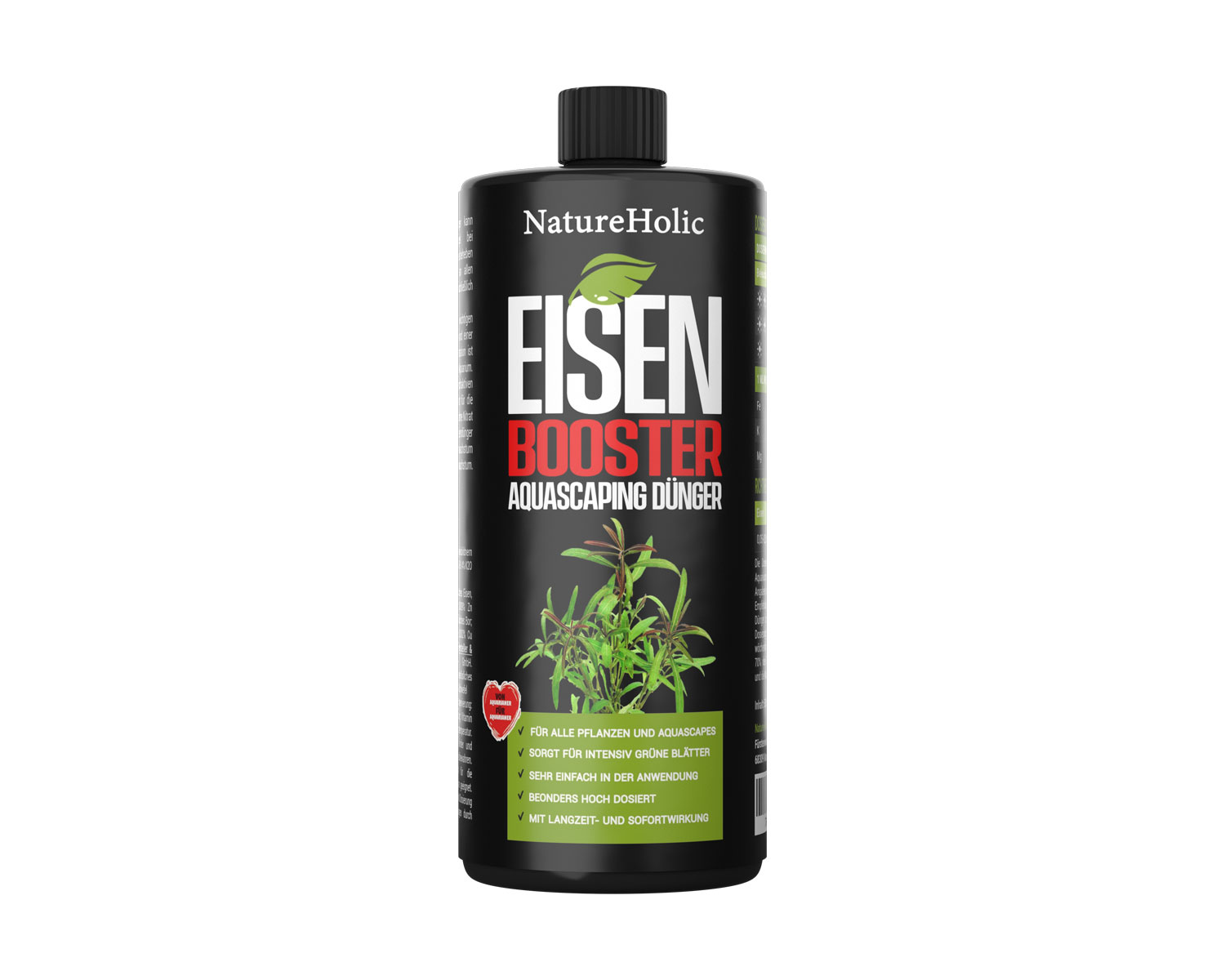
NatureHolic NPK Complete
For an all-round full supply of your aquarium plants with all micronutrients and macronutrients you provide with the NatureHolic NPK Complete liquid fertilizer for aquascaping and plant aquaristics. Here are not only the important macronutrients nitrogen (N) in the form of nitrate (NO3), phosphorus (P) in the form of phosphate (PO4) and potassium (K) already contained in the right ratio for most plant aquariums, but also micronutrients: iron (Fe) and magnesium (Mg). With this complete fertilizer you prevent all deficiency symptoms in your aquarium plants: Leaf necrosis, leaf chlorosis, discoloration of new shoots, limp, dull leaves or even stunted growth and pale leaf colors are a thing of the past. Algae plagues are also prevented by a well thought-out, convenient nutrient supply with the NatureHolic complete fertilizer NPK Complete.
NatureHolic NPK Complete aquascaping fertilizer is best given as a daily fertilizer, because this way the amount of nutrients available to the plants in the aquarium is always constant. The target value for nitrate in a planted aquarium is 10-20 mg/l, for phosphate 0.1-0.4 mg/l, for potassium 10-15 mg/l, for iron 0.05-0.2 mg/l and for magnesium more than 10 mg/l. Aquariums with strong lighting and with a CO2 supply are fertilized per 100 liters per day with 4 ml NPK Complete, without CO2 supply with 1 ml. In aquariums with medium strong light with CO2 fertilization system you dose 2 ml, without CO2 supply the amount is 0.5 ml. Low light aquariums with a CO2 supply get 1 ml, without CO2 supply 0.2 ml NPK Complete.
